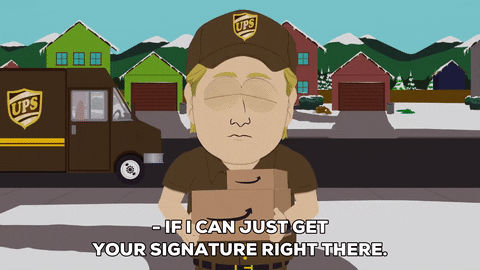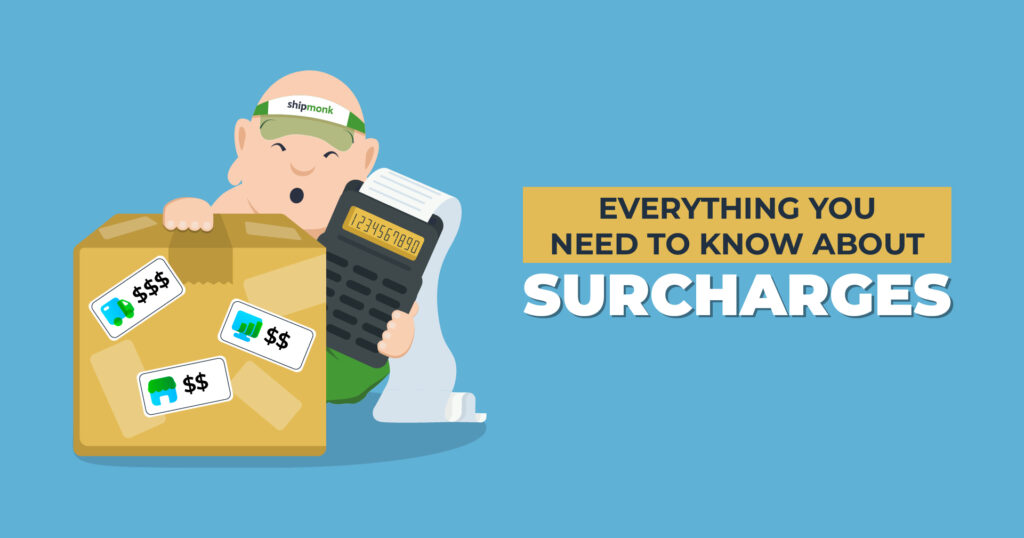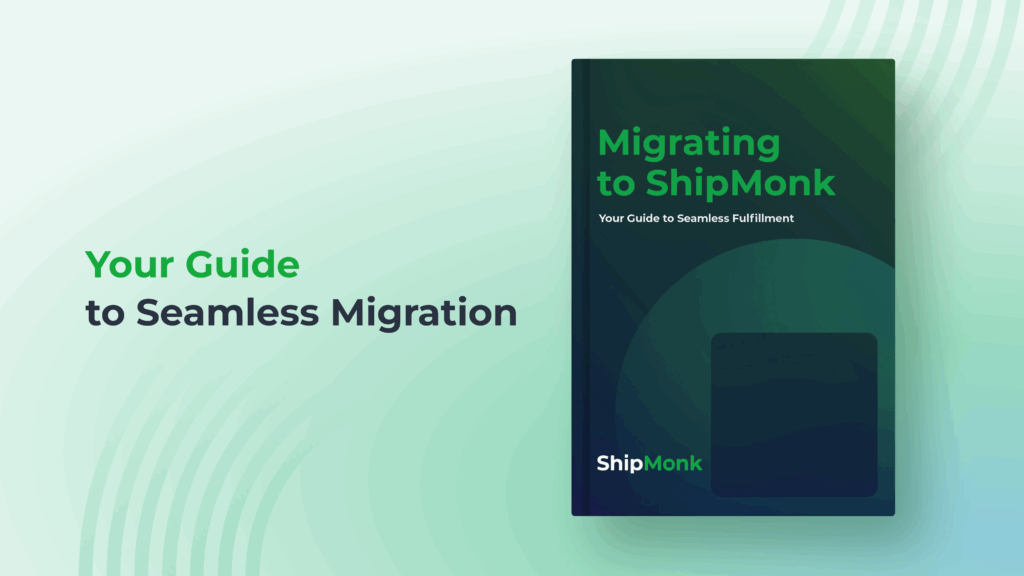To say that ecommerce shipping costs have skyrocketed over the past few years would be an understatement. Now that demand is easing and supply chain bottlenecks have cleared, we can expect shipping prices to decrease, right? Don’t count on it.
During the pandemic, as online shopping and demand for small-parcel shipping multiplied tenfold overnight, shipping companies found they could charge a premium for space on a limited number of trucks and cargo planes. Now, as demand settles closer to 2019 levels, inflation is being blamed for persistently elevated shipping costs. Shipping companies are finding it difficult to maintain the margins per parcel that they’ve previously enjoyed. Among the tools at their disposal are carrier surcharges, those seemingly random extra charges that add to your total shipping cost per package. What are these surcharges, and what can your ecommerce business do about them? That’s the topic of today’s blog post.

What is a Carrier Surcharge?
A surcharge is an additional, often unexpected charge that is added to the normal cost of a purchase. In the case of ecommerce shipping, it’s an extra cost, added by the carrier, to ship a package. Surcharges are meant to help carriers and shipping companies cover increases in operational costs due to forces outside their control, such as fuel price increases and rising labor costs due to labor shortages. But they seem to have multiplied over the years as shipping companies began treating them as a new source of revenue.
How Are Shipping Costs Calculated?
The total shipping cost for an ecommerce order shipment includes a base rate, plus any applicable surcharges.
Base Rate — Shipping carriers set a base rate for each shipping method they offer (i.e., 2-day, standard, economy, etc.). Rates are tiered within each method for various package weight ranges and destinations (zones). Carriers adjust their base rates annually, based on projected operating costs, shipping capacity, forecasted demand, fuel prices, and other factors. Large shippers, such as retailers, marketplaces, and fulfillment or logistics companies may be able to negotiate caps on annual rate increases. Smaller shippers tend to send all their volume through one carrier in hopes that they’ll get a discounted rate.
Surcharges — Surcharges are additional charges that protect shipping carriers from fluctuating costs not covered by their base rates. By instituting surcharges and changing them as costs rise and fall throughout the year, shipping carriers seek to maintain profitable margins for each delivery. Large shippers may be able to negotiate waivers for certain surcharges, but have no control over the surcharges they do pay.
Types of Shipping Surcharges
There are many different “reasons” for surcharges, and each shipping company might give each type a different name. So, while it seems as though there are hundreds of different types of surcharges, there are a few basic types.

Fuel Surcharge — Since diesel and jet fuel costs can change dramatically from one week to the next, shipping companies use a percentage-based system to calculate fuel surcharges which allows them to change rates quickly. Most carriers use the U.S. Energy Information Administration’s weekly price index as an input to calculate reimbursement costs. The EIA index is based on the national average for diesel prices, collected on a weekly basis from a sample of fueling stations throughout the United States.
Peak Season Surcharge — Shipping and logistics companies face elevated operating costs, such as seasonal staffing, during the holiday shopping spike. Surcharges allow them to pass on these increased costs. FedEx charges larger shippers based on how many more packages they are shipping compared to their normal weekly volume for residential and FedEx Ground Economy shipments between June 6 and July 3. FedEx calls this the shipper’s ‘peaking factor.’” In January 2023, carriers extended peak surcharges indefinitely.
Residential Surcharge — Not all shipping companies deliver to residential addresses, or charge a surcharge for doing so, because of how time-intensive last-mile delivery is. The USPS is the only parcel delivery service that does not charge a premium for delivering to residential addresses.
Delivery Area Surcharge — Because it takes a lot more time and fuel to deliver a small number of packages to less populated or less accessible areas, shipping companies add a surcharge for deliveries within certain zip codes in the U.S. For example, UPS assesses “Extended Area” and “Remote Area” surcharges “to more accurately reflect the cost of providing service to these areas.” As another example, FedEx assesses an $89 surcharge for delivering to a business on Chicago’s Navy Pier. View the complete list of 2023 FedEx surcharges here.
Handling Surcharge — There are many different types of handling charges, depending on the special handling required. There are surcharges for extra large or extra heavy packages, hazardous materials, packages that require a signature, inside delivery, or temperature protection, to name a few.
Inflation Surcharge — A catchall surcharge for rising costs, such as labor and supplies, during periods of inflation.
Fulfillment and Logistics Surcharge — In 2022, for the first time, Amazon instituted fuel and inflation surcharges, and began assessing a peak season surcharge for the fulfillment and logistics services it provides its FBA (Fulfillment by Amazon) sellers. Because Amazon owns its own warehouses and shipping fleets, independent FBA sellers have been shielded from peak season and other surcharges until now. As other shipping carriers raised rates, independent sellers flocked to the FBA program, straining Amazon’s operations. Now Amazon is passing these costs on to its FBA sellers.

The Problem with Surcharges
1. Ecommerce businesses can’t adequately anticipate their costs or manage their profitability when shipping costs vary so much from week to week.
2. FedEx and UPS own the 2-day-or-less shipping lane. They set their own rates, usually within pennies of each other, and have the highest fuel surcharges simply because they can. High volume shippers may be able to negotiate rate caps, but low-volume, small parcel shippers that need fast, long-distance shipping have no alternatives.
3. Fuel surcharges (and likely other surcharges) are not closely tethered to actual costs. According to a Cowen/AFS Freight news release in July 2022, “FedEx and UPS leveraged fuel surcharges as significant profit drivers, adjusting fuel surcharge tables twice since late 2021, with increases that continue to outpace corresponding indices from the U.S. Energy Information Administration on which they are based…. Diesel fuel rates increased by 69% year-over-year, but fuel surcharges more than doubled year-over-year for both carriers, with UPS growing from 8.0% in Q2 2021 to 17.3% Q2 2022 and FedEx increasing from 8.1% to 18.6% in the same timeframe.” Since then, diesel fuel rates have dropped 18%, while ground fuel surcharges only dropped 13%.
4. Surcharges are not going away. According to a January 2023 SupplyChain Dive article, “While a slowing economy is driving down ocean and trucking rates, last mile rates have remained persistently elevated….Despite volumes declining in recent quarters, 2023 is set to be another expensive year for FedEx and UPS shippers due to higher annual rate increases and surcharges.”
What Can You Do About Surcharges?
Unless you own your own shipping company you can’t avoid all surcharges, but there are ways to avoid certain types of surcharges and reduce your dependence on FedEx and UPS.
Eliminate Unnecessary Handling Requirements — Is that signature really necessary? Maybe better packaging would eliminate the need for temperature control or delicate handling.
Diversify Shipping Options — Seek out lower cost shipping options, including regional parcel carriers. Utilize the USPS for last-mile delivery, where there is no charge for residential delivery. Hybrid services like UPS SurePost, UPS Mail Innovations, or FedEx Ground Economy give you the best of both worlds.
Offer Customer Pickup — In rural or remote areas, offer customers the option to pick up their order at a designated spot in the nearest town.
Split Inventory to Position Goods Closer to Customers — Distribute your merchandise among multiple fulfillment warehouses across the country (or even globally) to reduce shipping distances and shipping costs. This not only reduces costs with the major carriers, it also allows you to leverage less expensive regional and local shipping carriers for more affordable 2-day delivery.
Partner with a 3PL for Discounted Rates — A high-volume third-party logistics (3PL) and fulfillment partner like ShipMonk has the leverage to negotiate lower rates with the big shipping companies. We also happen to have 12 state-of-the-art fulfillment centers in the US, Mexico, Canada, and Europe, which would help with the “split inventory” suggestion above. You’ll have access to the most advanced order, inventory, shipping and warehouse management software in the industry to manage orders and inventory from one easy-to-use system.

ShipMonk’s Virtual Carrier Network (VCN)
ShipMonk isn’t the only 3PL out there, but we’re the only one with a Virtual Carrier Network (VCN). That’s what we call our stress-free, carrier-neutral, mostly magical shipping selector. We’ve never liked the idea of being handcuffed to a single shipping carrier. Instead, the VCN sorts through all the shipping options available for each package you ship and picks the best, most economical way to get the package delivered on time. If one carrier is at full capacity, or not meeting SLAs (Service Level Agreements), we switch to another. And unlike transportation management companies, we don’t charge extra for this rate-shopping service.

When it comes to surcharges, ShipMonk’s VCN also helps you reduce the pain of constantly changing fuel surcharges. In addition to comparing carrier rates, capacity and performance for a particular package, the VCN takes potential surcharges into account. In the case of fuel surcharges, it standardizes the wide variations in cost by charging the same base rate and fuel surcharge within a certain group (i.e. packages with the same shipping method, weight and zones traveled). That means you pay the same low price for identical shipments, regardless of the carrier or shipping method.
Sound good? Drop us a line and we’ll show you how ShipMonk’s technology driven fulfillment solutions, multiple locations, and Virtual Carrier Network can reduce costs and help your ecommerce brand scale.





